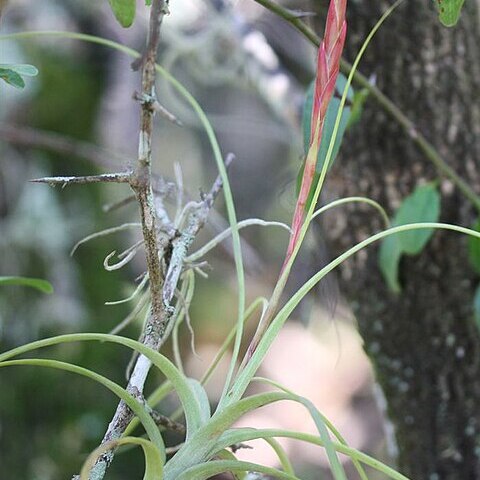Plant acaulescent, flowering 20-55 cm tall, with 8-15 somewhat cinereous-green leaves mostly exceeding the inflorescence, but often recurving, the sheaths forming a dense ovoid and cinereous pseudobulb. Leaves about 10-20, rigid-coriaceous, (20-)30-50 cm long, mostly longer than the inflorescence; sheaths distinct, contracted into the blades, ovate, greatly inflated-convex, 2.5-7.5 x 1.7-6 cm, with narrow thin margins, very densely (or obscurely) subappressed-lepidote and glabrous at the extreme base, pale-ferrugineously lepidote inside, often with a purple-red band at the margins; blades strongly recurved, very narrowly triangular, often involute at the margins (at least when dry), 17-45 x 0.7-1.8 cm, filiform-attenuate, very densely (sub-) appressed-lepidote throughout. Inflorescence densely bipinnate of 2-6 spikes or simple, (4-)9-17 cm long; scape erect, 13-30 cm long, ca. 4 mm in diam., glabrous, densely covered by bracts; scape bracts imbricate, chartaceous, ovate, with foliaceous to filiform blade, excluding the blade exceeding the internodes, densely appressed-lepidote at both sides, except near the bases, cinereous; axis mostly short, but partly exposed, almost straight, rugose when dry, glabrous; primary bracts as the upper scape bracts, but more caudate, exceeding and hiding the sterile bases of the spikes; spikes erect, subsessile (sometimes the apical spike with bracteate peduncle), linear-lanceolate, complanate, 3-7 x 0.8-1.1 cm, acute, with 1-2 imbricate sterile bracts at the base and apex, densely and distichously 3-10-flowered; rachis hidden at anthesis, flexuous, angled, glabrous; floral bracts imbricate, coriaceous, with even surface or slightly veined at the apex, ovate, 1.3-1.9 cm long, more than twice as long as the internodes, about as long as the sepals or slightly shorter, thin at the margins, obtuse or narrowly rounded and apiculate, two-angled below and fleshy carinate at the apex, sparsely appressed-lepidote in upper half and glabrous below, cinereous-green to coral-red. Flowers tubular-erect, sessile; receptacle obconic, ca. 2 mm long; sepals very thin-coriaceous, with even surface, ovate-oblong, 1-1.7 cm long, with broad veinless margins, broadly rounded, posterior ones connate for ca. 2 mm and sharply carinate for most of their length, anterior ones nearly free and ecarinate, glabrous or sparsely and obscurely lepidote inside toward the base; petals thin, ligulate, ca. 3.5 cm long, often pale-violet; stamens much exceeding the petals, filaments thin and hyaline, straight, flat below, exceeding part dilated, subterete and pale-violet, anthers dorsifixed nearly at the middle, 6-7 mm long, sagittate, but free basal lobes less than 0.5 mm long, bluntly apiculate; pistil just exceeded by the stamens (?); ovary slenderly ovoid, tapering into the slender style, stigmas spathulate, fimbriate, twisting-conduplicate. Capsule cylindric, ca. 4 cm long, narrowly obtuse, short-beaked.
More
Plants single or clustering, flowering to 75 cm. Stems short. Leaves 15--30, many-ranked, reflexed, twisted or contorted, gray, often flushed red, to 65 ´ 0.6--1.4 cm, appressed-grayish-scaly; sheath conspicuously rust-colored toward base, ovate to elliptic, conspicuously inflated, forming small pseudobulb, 2--4 cm wide; blade linear-triangular, leathery, channeled to involute, apex attenuate. Inflorescences: scape conspicuous, erect, 8--30 cm, 2--4 mm diam.; bracts densely imbricate, spreading, recurved and twisted like leaves; sheath of bracts narrowing gradually into blade; spikes erect, 2-pinnate, linear, compressed, 2--10 ´ 1 cm, apex acute; lateral branches 2--10 (rarely simple). Floral bracts imbricate, erect, green to red, broad (covering all or most of rachis, rachis not visible at anthesis), elliptic, keeled, 1.5--2 cm, leathery, base not visible at anthesis, apex acute, surfaces glabrous to inconspicuously scaly near apex only, venation even to slight. Flowers 5--30, conspicuous; sepals with adaxial pair connate, lanceolate, keeled, 1.5--2 cm, leathery, apex acute, surfaces glabrous; corolla tubular; petals erect, violet, ligulate, to 3.5 cm; stamens exserted; stigma exserted, conduplicate-spiral. Fruits to 4 cm.
Plant stemless, 13-65 cm. high. Leaves many, densely and minutely pale-appressed-lepidote, often purple-margined; sheaths ovate, large, inflated, forming an ovoid or ellipsoid pseudobulb to 12 cm. long, pale-ferruginous toward base; blades abruptly spreading or recurved from the apices of the sheaths, linear, filiform-acuminate, 1 cm. wide, usually all involute. Scape erect or ascending, slender, subglabrous. Scape-bracts imbricate, elliptic with long linear spreading or re-flexed blades, inflated. Inflorescence densely pinnate or subdigitate or rarely simple, slenderly fusiform or subcylindric, to 2 dm. long. Primary bracts like the upper scape-bracts, at least their sheaths shorter than the axillary spikes. Spikes sessile, strict, linear, acute, complanate, 3-12 cm. long, 12 mm. wide. Floral bracts imbricate, ovate, obtuse and apiculate but often appearing acute, 15-22 mm. long, exceeding the sepals, coriaceous, even or slightly nerved toward apex, glabrous or obscurely lepidote, ecarinate, often bright red. Flowers subsessile. Sepals lanceolate, acute, glabrous, connate posteriorly. Petals tubular-erect, obtuse, 30-45 mm. long, violet. Stamens exserted. Capsule cylindric, 4 cm. long.

